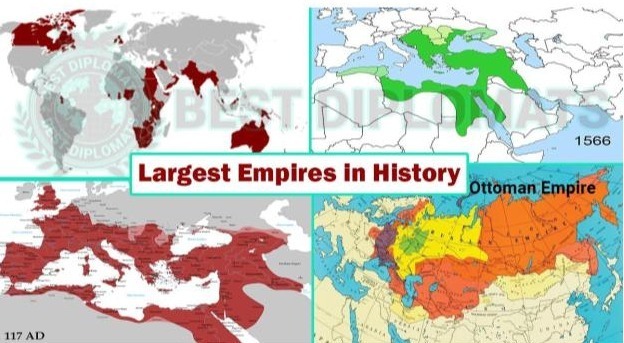
There have been numerous empires throughout history, but various empires have sought to increase their power and influence beyond their original territorial borders. All these largest empires have experienced the peak times of success before their downfall. This article provides a brief description of the largest empires in the world's history from the British Empire to the Ottoman Empire which was declined in 1922. This article covers their period, successes, and the reasons for their downfall. These immense empires, each with its distinct infrastructure, provide insight into how human civilization has changed all over time and influenced the development of the modern world.
List of 10 Largest Empires in History
Here is the list of the 10 largest empires in history;
British Empire
Mongol Empire
Russian Empire
Qing Dynasty
Spanish Empire
Yuan Dynasty
Ming Dynasty
Umayyad Empire
Abbasid Caliphate
Ottoman Empire
1) British Empire
The British Empire was the largest empire the world had ever seen. In 1920, the British Empire experienced a peak size of 22 percent of the earth’s land mass which is 13.71 million square miles. The empire's population was more than 20 percent of the world’s population which is 458 million people.
It expanded with trading posts, overseas colonies, and wars. The British Empire was one of the strongest empires that even today the world has its influence such as the English language and culture. After World War I, post-colonialism ended the British Empire. Many of the territories gained independence and some retained their part called the Commonwealth of Nations
2) Mongol Empire
The Mongol Empire has played an important role in the world’s history. It flourished from 1206 until 1368. It comprised the nomadic tribes from Central Asia and stretched to Central Europe and the Sea of Japan and then to western Asia Minor ( Turkey) at its peak time. Genghis Khan is the founder of the Mongol Empire and one of the best-known leaders of his time.
In addition to its brutal warfare strategies, the Mongol Empire is popular for fostering trade and unifying different cultures. Despite its prosperity, the passing of Genghis Khan and some other events led to the downfall of the empire.
3) Russian Empire
The Russian Empire which flourished from 1721 until 1917 was a powerful political entity that stretched over large parts of Eurasia. It covered 8.8 million square miles of land in 1895. The population of the Empire was 125.6 million from various territories, cultures, languages, and religions. The Russian Empire played a vital role in halting Napoleon's annexation of Europe and turned into a major European power.
The Russian Empire extended from Asia's northern coast to the borders of present-day Iran and Afghanistan and from the eastern border of Germany in the west to the Bering Sea in the east. Today's Russian Federation still retains much of the territory of the former Russian Empire.
4) Qing Dynasty
The Qing Dynasty was founded by the Manchus, people of northeast Asia. It flourished from 1644 until 1911. The Qing Dynasty was the most prosperous and the world’s largest empire in the 18th century. The early era of the Qing Dynasty experienced relative stability, with an increase in population which led to immense trade, more agricultural output, and expansion of diverse cultural life.
Eventually, this prosperity led to its downfall. The increase in population demands more employment opportunities and ultimately leads to poverty. The instability of the dynasty was threatened by anti-Qing revolts which sprang out of this resentment among people. However, the military might and territorial expansion of the Qing Empire will always be recognized in Chinese history.
5) Spanish Empire
The Spanish Empire emerged from the European Age of Discovery and was one of the long-lasting empires of the world. It is also considered as the most powerful colonial empire in world history. It was led by Spain and Portugal and soon became the superpower of the world. The Spanish Empire extended over 5.29 million square miles of land in the late 1700s which was its peak time. It flourished from 1492 until 1976.
The Spanish colonies were stretched across South and North America, and the Caribbean. The Spanish Empire was an immense economic and military power across Latin America, North Africa, and much of Europe. Even today, the influence of the empire has been seen through the Spanish language, architecture, and law in these regions.
6) Yuan Dynasty
The Yuan Dynasty was founded by Kublai, the fifth khagan emperor of the Mongol Empire and the grandson of Genghis Khan. It emerged to rule China in the late 13th Century due to the break up of the vast Mongol Empire into separate empires. It flourished from 1271 until 1368. It had control over present-day China, the Korean Peninsula, and Mongolia. It extended over 4.25 million square miles of the world’s land and contained 17 percent of the world’s population.
The dynasty experienced an increase in trade with foreign states as well as a visit from Marco Polo, the famed Italian merchant. However, in the mid-14th century, its downfall started and it was replaced by the Ming Dynasty.
7) Ming Dynasty
The Ming Dynasty was the imperial dynasty of China, ruled by the Han people, the ethnic majority group of China. It was established by the emperor Taizu following the collapse of the Yuan Dynasty and flourished from 1368 to 1644. The Ming dynasty held trade as its priority and sent ships to the Persian Gulf, India, and the East Coast of Africa. It allowed the European presence in the region by exporting silk and the expansion of the cuisine.
During the Ming Dynasty, a significant number of merchant-class immigration was observed outside of the empire. Porcelain was the most popular export of the Ming dynasty which led to the establishment of a porcelain factory in 1368. Further, the Great Wall of China was also repaired during the Ming dynasty. In 1642, the dynasty was separated into two new dynasties by two rebel leaders, leading to the fall of the Ming dynasty. After the death of the last Ming emperor, the semi-nomadic Manchu people took control and founded the Qing Dynasty.
8) Umayyad Empire
The Umayyad Empire or Caliphate was one of the largest empires in the world’s history. It extended over 4.29 million square miles of the world’s landscape covering much of the MENA region ( Middle East North Africa). It flourished from 661 to 750 and contained 29 percent of the world’s population.
The Umayyad Empire comprised nomadic Berber tribes and had an immense influence on the Sahara region. Within the larger confines of the Caliphate, the power lay with the local emirs and sultans who were the rulers of their area. The Umayyad Empire played an instrumental role in introducing Islam and developing Islamic culture in much of West Africa under its rule.
9) Abbasid Caliphate
The Abbasid Caliphate is the third Islamic Caliphate succeeded by the founder of Islam, Prophet Muhammad (PBUH). It replaced the Umayyad Caliphate in the mid-8th Century and claimed Baghdad as its capital. It extended over 4.29 million square miles of land and contained an unknown number of population. It flourished from 750 until 1258.
However, the Golden Age of Islam also began during the rule of the Abbasid Empire or Caliphate. It extended the coast of North Africa in the west ( which is today’s Algeria) to the Western border of India in the east. The influence of the Abbasid Caliphate started to fall when the Turkish military rose to power and finally diminished with the arrival of the Ottoman Empire.
10) Ottoman Empire
The Ottoman Empire was one of the most powerful empires in the world. It was established by the Turkish tribal people in Asia Minor ( Anatolia) and flourished during the 15th and 16th centuries. The Ottoman Empire was established by the nomadic Turkmen chief, Osman I.
At its peak time, it extended over most of southeastern Europe including present-day Balkan states, and the gates of Vienna, Hungary, Greece, and some parts of Ukraine as well as part of the Middle Eastern region which is now occupied by Syria, Iraq, Egypt, and Israel. Further, it was also extended to North Africa and a large portion of the Arabian Peninsula. The Ottoman Empire ruled for more than 600 years and collapsed in 1922 with the creation of the Turkish Republic.
Conclusion
The world has seen the rise and fall of numerous empires throughout history with remarkable impacts on human civilization. These geopolitical empires have shaped the history of the world. From the British Empire to the Ottoman Empire, their legacy was characterized by economic dominance, cultural diffusion, and military power and conquest. The information about these empires offers remarkable insights into the power complexities, interplay of diverse cultures, and global governance. Concludingly, the reflection on the largest empires of the world acknowledges the transient nature of imperialism and reminds us of how human societies and civilizations are constantly evolving and changing.
FAQs
What is the biggest empire in history?
The British Empire, with control over 23 percent of the world’s population and a vast expansion over 13.71 million square miles remains the biggest empire in history.
What was the fastest-growing empire in the history of the world?
The Mongol Empire was the fastest-growing empire in the world’s history. With military might and power, it had conquered the largest area of the world in a short time.
Name the largest empires in the world.
There are many largest empires in the world including the British Empire, the Mongol Empire, the Russian Empire, the Roman Empire, the Byzantine Empire, and the Ottoman Empire.
Original Source of the original story >> Top 10 Largest Empires in History






